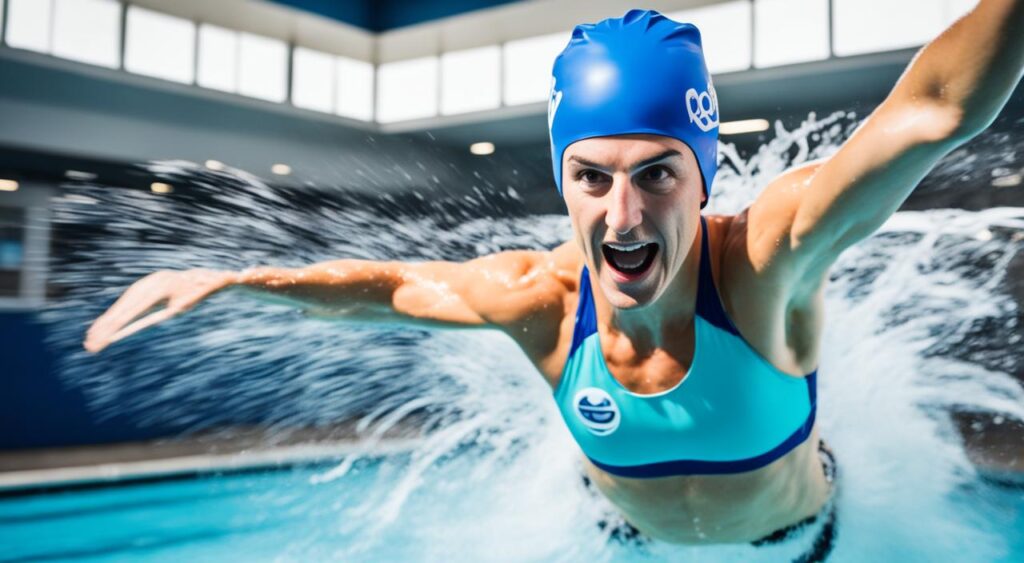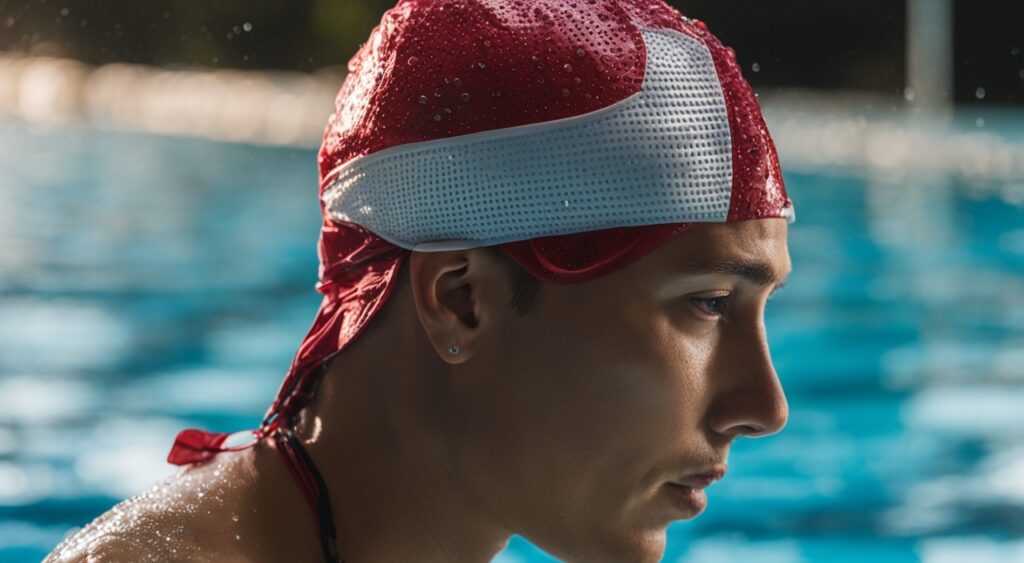Do Swim Caps Keep Hair Dry? The Truth Revealed
Explore the world of swim caps and learn how they help keep hair dry when swimming. Whether you’re a competitive swimmer or just enjoy the pool, knowing how swim caps work is key. We’ll look into why swim caps are important, their benefits, and what affects their ability to keep hair dry.

Swim caps are a must-have for swimmers, but many don’t know their true purpose. By understanding why and how swim caps work, you can decide if they’re right for you.
What is a Swim Hat and Why Use One?
A swim hat is a tight-fitting headpiece for swimmers. It keeps their hair dry and out of their face while in the water. This accessory is key in swimming, offering many benefits beyond just keeping hair dry.
Understanding the Purpose of Swim Caps
The main job of a swim cap is to protect waterproof hair from the pool. It acts as a barrier, keeping chlorine and other chemicals away from the hair. This is vital for those with long or thick hair, as it reduces tangles and keeps the hair shiny and healthy.
Benefits of Using a Swim Cap
- Protects hair from chlorine and other pool chemicals that can cause dryness and damage
- Keeps hair neatly contained and out of the swimmer’s face, improving visibility and reducing drag in the water
- Enhances the overall swim cap benefits by reducing the amount of water that enters the cap, helping to maintain a streamlined and hydrodynamic profile
- Helps preserve the longevity of the swimmer’s swimming hair care routine by minimizing the need for frequent washing and conditioning.

Whether you’re a competitive swimmer, a recreational lap swimmer, or just enjoy swimming, a swim cap is a great addition to your swimming hair care routine. It keeps your hair dry and protected, letting you focus on your performance and enjoy swimming without worrying about your hair.
Does a Swim Cap Keep Hair Dry?
Swimmers often wonder: do swim caps keep your hair dry? The answer is complex. It depends on the cap’s material, fit, and your hair type.
Swim caps aim to block water from reaching your hair. But, their success varies. The material, like silicone or latex, and how well it fits matter. So does your hair’s length and thickness.
Short, thin hair might stay drier with a good-fitting swim cap. But, longer or thicker hair might still get wet. In these cases, extra steps are needed to how to keep hair dry while swimming.
Maximizing Swim Cap Effectiveness
- Choose a swim cap that fits your head well.
- Go for swim caps made of silicone or latex for a better seal.
- If you have long or thick hair, try a double-layered cap or use a waterproof hair product first.
A swim cap can help keep your hair dry, but it’s not foolproof. Knowing what affects its performance helps swimmers make better choices. This way, they can enjoy swimming with drier hair.

Factors Affecting Swim Cap Effectiveness
Choosing the right swim cap can make a big difference in keeping your hair dry. The type of material and design of the cap, along with your hair’s length and thickness, are key factors. These elements greatly affect how well the cap protects your hair.
Swim Cap Material and Design
The material of a swim cap is crucial for its water resistance. Silicone caps are known for their tight seal, keeping water out well. Latex or rubber caps are cheaper but might not be as effective.
The cap’s design also matters. Caps that fit closely are better at keeping water out. Loose or oversized caps let water sneak in.
Hair Length and Thickness
Your hair type can affect how well a swim cap works. Long and thick hair can make it tough for the cap to seal tightly. Short and fine hair might find it easier to stay dry.
Choosing the right swim cap means finding the right balance. Consider the cap’s material, design, and your hair type. This way, you can pick the best cap for your needs.
How to Keep Black Hair Dry While Swimming
Keeping black hair dry while swimming can be tough, but you can do it with the right methods. A well-fitted swim cap is key to keeping your hair dry. It helps a lot in preventing water from getting into your hair.
Here are some tips to help you keep your black hair dry in the pool:
- Opt for a swim cap made of silicone or latex. These materials create a tighter seal around the head, preventing water from seeping in.
- Make sure to thoroughly cover all of your hair, including the nape of your neck, when putting on the swim cap. Leaving any gaps can allow water to enter.
- Apply a generous amount of hair oil or serum to your hair before putting on the swim cap. This helps create a barrier against water absorption.
- Consider wearing a double swim cap, with a silicone or latex cap over a lycra or nylon cap, for added protection.
- Avoid using a swim cap that is too tight, as this can cause discomfort and may not provide an effective seal.
Using a well-fitted swim cap is just the start. You can also take other steps to keep your hair dry. Apply a leave-in conditioner or hair serum before swimming to protect your hair. Make sure to rinse your hair well with fresh water after swimming to remove chlorine or other chemicals.
By following these tips, you can keep your black hair dry and healthy while swimming.
Tips for Keeping Hair Dry in the Pool
Keeping your hair dry while swimming can be tough, but the right methods can help. You can protect your hair from pool water damage. Here are some tips for dry and healthy hair during pool time.
Proper Swim Cap Application
A good fit is crucial for your swim cap. Here’s how to apply it right:
- Gather all your hair into a tight bun or ponytail before putting on the cap.
- Gently stretch the cap and place it over your head, starting from the forehead and working your way back.
- Smooth out any wrinkles or gaps around the edges to create a tight seal.
- Adjust the cap as needed to ensure a snug, comfortable fit.
Protecting Hair Before and After Swimming
Getting your hair ready before and after swimming helps keep it dry. Here are some tips:
- Apply a leave-in conditioner or hair oil to your strands before putting on the swim cap. This can help create a barrier against pool water.
- Rinse your hair with clean water before and after swimming to dilute any chlorine or chemicals.
- Gently pat your hair dry with a soft towel and avoid rubbing vigorously, which can cause damage.
- Consider styling your hair in a bun hairstyles to keep it secure and dry during your swim.
Preventing Hair Damage From Pool Water
A swim cap can protect your hair from direct pool water contact. But, pool water, especially chlorinated water, can still harm your hair. To avoid hair damage, it’s key to know how chlorine affects your hair and how to remove it.
Chlorine Removal Techniques
Chlorine keeps pool water clean but can dry out and damage your hair. Here are ways to fight chlorine’s effects:
- Use a clarifying shampoo or chelating shampoo before and after swimming to remove chlorine and other mineral buildup from your hair.
- Apply a deep conditioning treatment or hair mask after swimming to help replenish moisture and strengthen your strands.
- Rinse your hair with fresh water before and after swimming to dilute the chlorinated pool water.
- Invest in a swimming hair care routine that includes a leave-in conditioner or hair oil to protect your hair from the drying effects of chlorine.
Using these techniques can help prevent hair damage. This way, your hair stays healthy and vibrant, even with lots of pool time.
Bun Hairstyles for Swimming
When swimming, certain hairstyles keep hair dry and secure. The bun is a top choice for swimmers. It prevents water from getting into your hair and keeps strands in place.
Buns are great for swimmers. They lock in moisture and keep hair dry, especially for long or thick hair. They also fit securely and comfortably, keeping your hair in place during swimming.
Creating the Perfect Swim Bun
To make a swim bun, follow these steps:
- Start with clean, dry hair. Brush or comb through to remove tangles.
- Gather your hair into a high ponytail at the crown of your head.
- Twist the ponytail into a tight bun, wrapping the hair around itself.
- Use bobby pins or a swim cap to keep the bun in place.
- Apply a light-hold hairspray or gel for extra hold.
These steps help you create a sleek, functional bun. It keeps your hair dry and out of your face while swimming. Try different bun styles to find what suits your hair and style best.
Water-Resistant Swim Cap Options
Not all swim caps are the same when it comes to keeping your hair dry. Some are made with materials that resist water well. Let’s look at some top water-resistant swim cap options to help you pick the right one.
Silicone Swim Caps
Silicone swim caps are a top pick for staying dry in the water. They’re made of a flexible, strong material that fits your head tightly. This keeps water out. Plus, they’re comfy and fit well, perfect for swimmers who want their hair dry.
Neoprene Swim Caps
Neoprene swim caps are great for staying dry too. This material is a synthetic rubber that fights water well. It’s perfect for keeping hair dry. Plus, it keeps you warm in cold water.
Latex Swim Caps
Latex swim caps are a wallet-friendly choice that still keeps hair dry. They might not last as long as silicone or neoprene, but they work well. They’re also light and comfy, making them a good pick for many swimmers.
When picking a swim cap, think about the material, fit, and what you need. The right water-resistant swim cap lets you swim without worrying about your hair getting wet.
- Silicone swim caps offer a tight seal and flexible, durable material for superior water resistance.
- Neoprene swim caps provide excellent water-resistant performance and insulating properties.
- Latex swim caps are a budget-friendly option that can also keep your hair dry during swimming.
Swimming Hair Care Routine
Keeping your hair healthy before and after swimming is key. It doesn’t matter if you swim often or just sometimes. A few simple steps can protect your hair from chlorine and meet your swimming hair care needs.
Pre-Swim Hair Care
Before you get in the pool, prepare your hair. Apply a small amount of leave-in conditioner or hair serum. This protects your hair and keeps moisture in. Consider wearing a swimming hair cap for extra protection.
Post-Swim Hair Care
After swimming, rinse your hair with fresh water to get rid of chlorine. Use a gentle, sulfate-free shampoo and a deep conditioning treatment. Avoid heat styling and harsh chemicals for a few days to let your hair recover.
Follow these easy swimming hair care tips to enjoy swimming without harming your hair. Being proactive in caring for your hair while swimming helps prevent damage. This way, you can keep your hair healthy and looking great.
Pool Hair Damage Prevention Strategies
Keeping your hair safe from pool water damage is key for swimmers. Using a swim cap and following a good hair care routine is important. But, there are more steps you can take to protect your hair.
Applying a leave-in conditioner or hair oil before swimming helps. It acts as a shield, keeping water and chlorine away from your hair. Choose products made for swimmers to fight the drying effects of pool chemicals.
- Apply a leave-in conditioner or hair oil before swimming to create a protective barrier.
- Opt for products designed for swimmers that help counteract the drying effects of chlorine.
Wetting your hair with clean water before swimming is another good idea. It lessens the amount of pool water your hair absorbs. This helps avoid hair dryness and damage. Also, rinsing your hair with clean water after swimming removes chlorine and other bad stuff.
- Wet your hair with clean water before putting on your swim cap to reduce pool water absorption.
- Rinse your hair with clean water after swimming to remove any remaining chlorine or contaminants.
Using these tips with a swim cap and a good hair care routine can keep your hair safe. With a bit of extra care, you can swim and still have great-looking hair.
Conclusion
This article has looked into how swim caps keep hair dry and what affects their performance. It helps swimmers know what they need for hair protection. By understanding the benefits of swim caps, swimmers can make better choices for their hair.
The article also answered if swim caps really keep hair dry. It talked about how swim cap materials, hair type, and pool conditions work together. It gave tips on how to put on a swim cap right and how to care for your hair before and after swimming. This helps swimmers keep their hair healthy and dry while swimming.
Finally, this article gives swimmers the tools to protect their hair’s health and look. It lets swimmers enjoy swimming without worrying about their hair. By using these tips, swimmers can keep their hair dry, shiny, and strong, even after being in the pool for a long time.